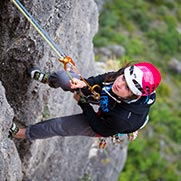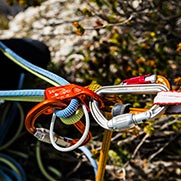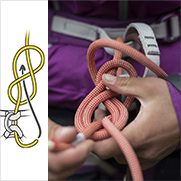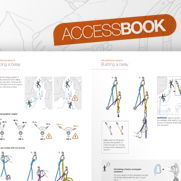Choice of carabiners for attaching a HUIT, RACK... to the harness
Warnings
- Carefully read the Instructions for Use used in this technical advice before consulting the advice itself. You must have already read and understood the information in the Instructions for Use to be able to understand this supplementary information.
- Mastering these techniques requires specific training. Work with a professional to confirm your ability to perform these techniques safely and independently before attempting them unsupervised.
- We provide examples of techniques related to your activity. There may be others that we do not describe here.
Key issues and risks
The large attachment hole allows the device to move freely around the carabiner: it can exert leverage on the sleeve and break it in severe cases.
When the rope is taut, the carabiner and the device are held in position by the tension. But when the rope is slack, the device and its carabiner can move about and become poorly positioned.
The most important risks to consider
Recommendation on carabiner and accessories
- Use a D-shaped carabiner
- Choose a locking system according to your preference
Why this choice?
• The D shape, with its very acute angles, helps resist carabiner rotation.
There is only one device to attach, so a wide opening and high capacity are not necessary
• Depending on the application (sport or work, use of a backup belay system...) it is possible to choose a locking system to prioritize speed of operation (SL, RL) or to prioritize security (TL, BL)
Precautions for use
• Regularly monitor your belay device and the positioning of the carabiner during use, especially when it is reloaded after having been unloaded
• Verify that the sleeve is properly locked at each connection (red indicator not visible)
• With an auto-locking carabiner, check at each opening and closing that the sleeve is completely locked
• Avoid any pressure or rubbing that could damage or unlock the locking sleeve, and/or cause the gate to open
Note
In this application, pear-shaped carabiners have a tendency to rotate and become poorly positioned.









